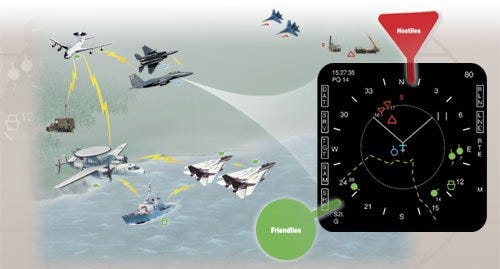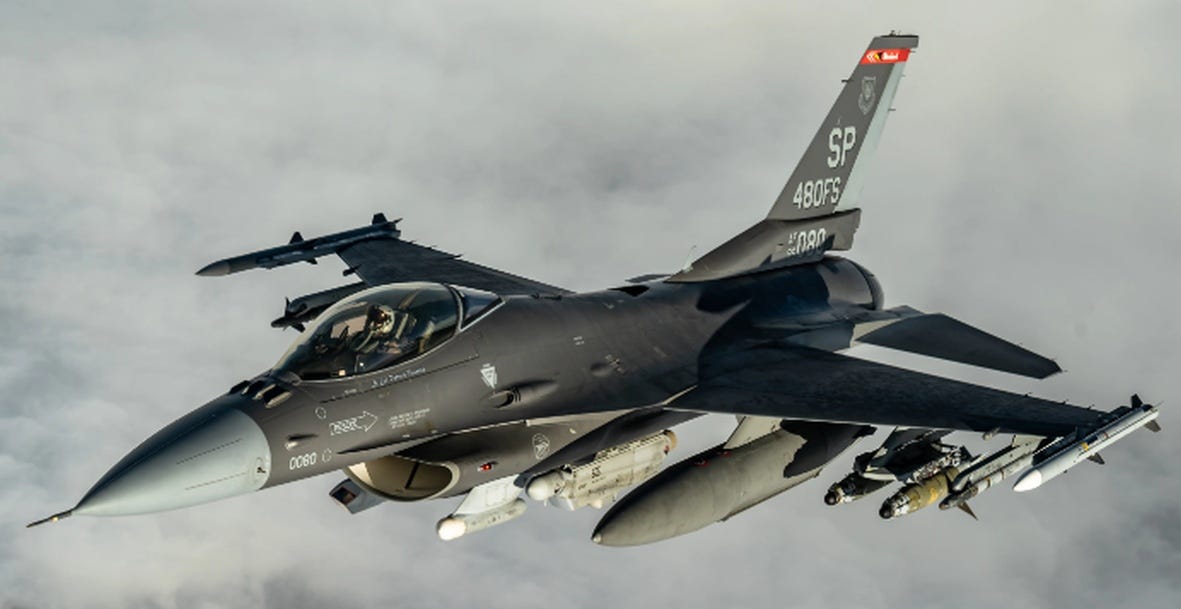It's the Range, Stupid... Part 2
Hello everybody!
In the Part 1 of this feature, I’ve emphasised the importance of 'range': the range of radars installed into combat aircraft, and the range of weapons - primarily air-to-air missiles - used to equip them. This prompted many reactions from different readers, each highlighting one or another of what I call ‘sub-factors’ of air combat. And yes: have no doubt, you’re all correct: there are numerous such sub-factors and the outcome of an air combat is not determined solely by the radar- and missile range. Indeed: there are so many sub-factors, alone trying to list all of them would easily fill several books.
Therefore, today, I'm going to discuss at least the basics about most important factors. Not only to make sure I do know what are you talking about, and thus what am I talking about, but also to make sure all the other readers understand what is important: indeed, how the modern air combat ‘works’, and why.
In this place, let me express my thanks to Stefan, Ed, Phil, and few others for providing lots of ‘clues’ and ‘leads’ about what to add to this feature; and, let me thank everybody else for lots of highly interesting- and inspirational questions!
Contrails
First and foremost, remember that all aircraft, whether civilian or military, spend 99.99% of their operating lives flying straight. Like this:
…or this:
There are several reasons for this. Chief among them is that aircraft are tools for traveling from point A to point B, and… well.. one can rarely travel from point A to point B if constantly flying in circles. Even if a combat aircraft is intended to return to the exact base from which it launched, it will still spend most of its mission flying in straight lines, just like an airliner, because that is the only way the aircraft can fly from its base to the point of action and then back.
Thus, when you think about combat aircraft, think about them as you think about airliners: machines flying straight, most of the time.
The only difference between airliners and combat aircraft is that, IF needed, combat aircraft can also perform very tight turns. Pilots call this ‘pulling gs’, and are ‘grading’ aircraft by the amount of gs they can pull. Colloquially, this is related to as ‘manoeuvrability’: the tighter turns an aircraft can fly ‘the more manoeuvrable’ is it considered.
You’re going to hear many describing the F-16 as ‘very nimble’ or ‘highly manoeuvrable’: meaning it can pull lots of gs, or fly very tight turns. Indeed, even its latest versions remain some of most manoeuvrable combat aircraft in operational service today. However, and once again: for reasons described above, this doesn’t mean that once airborne they’re all the time pulling tight turns. On the contrary: 99.99% of their operational life, F-16s fly just like any other aircraft.
They fly straight.
Situational Awareness
Another reason for this is that flying hard turns - pulling lots of gs - tends to ruin a pilot's situational awareness, which is their understanding of their surroundings and events happening around them in real-time. Situational awareness is the crucial factor in modern air combat. It involves actively monitoring and interpreting information about one's environment, recognizing potential threats or opportunities, and making informed decisions based on that information. Situational awareness is so important that either one has situational awareness and wins, or one has none or less of it – and 'automatically' loses the air combat.
Situational awareness is of such importance that over 90% of modern air combat actually consists of anything else than fighting the air combat: it involves obtaining superior situational awareness through gathering intelligence in real time, assessing enemy’s capabilities and intentions, and bringing own aircraft into favourable positions. As a result, while most people still think about air combat in terms of ‘dogfight’ – aircraft manoeuvring around each other to obtain a favourable position for a stern-attack with guns – actually, the bulk of modern air combat takes place while aircraft are still 100, 200 and/or more kilometres away from each other: in what could be described as the ‘pre-commitment’ phases of air combat. During these phases, pilots – and lots of people on the ground, all tasked with supporting pilots (or not: though then the battle is already lost) – are trying to detect enemy aircraft, assess their type, their capabilities, and their intentions. Point is that the ‘commitment’ starts – or should start – only once own side is certain it has the necessary situational awareness; that,
A) it has enough information about the enemy to bring itself into a favourable position and then deploy its equipment and weapons with in a reasonably high degree of effectiveness, and
B) it has enough information to avoid enemy’s action: indeed, to deny the enemy the capability to detect own aircraft, or at least the option of opening fire.
System of Aerial Warfare
That’s the very essence of the purpose of the situational awareness. The next question is therefore: how does one obtain situational awareness?
The answer is so important that it’s already since the 1950s and 1960s, that all the combat aircraft – no matter their origin – are actually designed to be operated within a very specific system of aerial warfare. In military jargon, this is defined as ‘requirements’. Major requirements are obvious from flight performances and data about the avionics-configuration of an aircraft. For example: F-16AM is equipped with the APG-66 radar, and can reach supersonic speeds, while its structure is reinforced to enable sustained 9g-turns….
Sounds great, doesn’t it? Indeed, so much so that plenty of people think that’s perfectly enough. However, that’s just a literal ‘tip of an iceberg’, and anything else than enough.
Actually, the F-16 was designed to serve as a light-weight fighter, relatively cheap to obtain and thus affordable in big numbers, and – even more so – to be operated in a war while supported by an entire host of support-platforms. These support platforms are ranging from such aircraft like Lockheed U-2/TR-1 reconnaissance aircraft, via Boeing RC-135 electronic gathering aircraft, to Boeing E-3 Sentry airborne early warning and control aircraft. And even that is still, ‘just the tip of an iceberg’. Like all other Western aircraft types, the F-16 was also made in expectation it is going to be supported by a host of very powerful intelligence services, teaching its pilots everything they need to know about enemy aircraft and weapons performances, tactics of their fliers… even names of specific enemy pilots. Over the time, the F-16 was modified to receive the resulting ‘intelligence’ in real-time, via such aids like ‘Link-16’: essentially, this is a powerful ‘modem’, enabling exchange of encrypted information between the combat aircraft, support platforms (like other F-16s, like ground-based radars, even ground-based air defence systems, like PAC-2/3 Patriot, IRIS-T and other recently delivered by NATO to Ukraine, and ground bases) and that in real time. Something like ‘military-grade internet for combat purposes’.
The ‘beauty’ of the Link-16 is that it is vastly expanding pilot’s situational awareness. By receiving a constant feed of intelligence from so many different sources, the pilot ‘knows’ as much as he/she only can know about enemy positions and capabilities. Sometimes about enemy’s intentions, too.

All of this technology involved results in very specific types of training and tactics in which it is employed. Like the Russian pilots – and their commanders – are trained to deploy their MiG-31BMs and Su-35S’ in very specific ways (primarily those exploiting advantages in regards of their flight performances, avionics, and armament), Ukrainian pilots – and their commanders – will have to train to deploy their F-16s so to exploit the advantages offered by their technology, their equipment.
This is a complex process, which is going to take them time to learn. It’s made harder by the fact that although the West has exceptionally good intelligence on older types in Russian service, like MiG-31, it has never encountered either this or the Su-35 in actual combat. All there is about how to counter these two types are unproven theories. The situation is going to be further hampered by the fact that while having a well-integrated (ground-based) air defence system: Ukraine might get the Link-16 together with F-16s, but lacks nearly all the support platforms the F-16 needs to ‘work’ effectively: it has no U-2/TR-1s, no RC-135s, and surely no E-3As. It doesn’t have even tanker aircraft to help stretch their endurance, once F-16s are airborne – like is a norm in almost all the Western air forces for decades already. And Ukrainians will be learning by doing, much of the time: sometimes suffering costly and painful losses, setbacks in the process.
Should Ukraine not get anything comparable to the Link-16 to support its F-16s (right now, this is anything else than certain), that’s only going to increase problems of its air force, because not only that F-16s need such equipment to be operated effectivelly, but also because the Russians have good capabilities to support their MiG-31s and Su-35s by their A-50 airborne early warning aircraft, by their huge network of ground-based radar stations, electronic warfare stations, and surface-to-air weapons. Because, right now, the Russians are still capable of providing their pilots with superior situational awareness to that of Ukrainian pilots.
Thus, providing the Link-16 to Ukraine together with F-16AMs, is going to be almost as important as actually delivering the aircraft. Anything less would render them of little use but as ‘drone/cruise-missile hunters’, and they would be nothing better in this task than the existing MiG-29s and Su-27s.
Because their pilots would not have the situational awareness necessary to outfight their Russian opponents.
Have Glass, any?
Ukraine and Russia are operating a relatively impressive line-up of combat aircraft types. Regardless their design, all of these have one thing in common: originally, all came into being in the 1970s, before the advent of stealth technology – and, actually, all are obsolete by today’s standards. As a result, they lack the ability to evade detection by radar and other modern surveillance systems. This makes them vulnerable to enemy fire and is massively limiting their effectiveness. So much so, that this air war is, de-facto, in the state of a standstill since early March 2022: all that both sides are doing ever since is searching for ways to launch their air-launched weapons from outside the range of enemy’s weapons, or outside their engagement envelopes.
This is about the only area where F-16AMs in the process of being delivered to Ukraine might enjoy a limited advantage: they might – mind: might, this is anything else than certain – come together with the so-called ‘Have Glass’ modification. Essentially, Have Glass consists of the application of radar-absorbent colour on the aircraft’s skin, aiming to reduce their radar cross section (also: ‘radar signature’ or ‘radar profile’): to make their radar echo appear ‘smaller’ on radar and thus make them detectable only from much shorter ranges than this would usually be the case.

In blunt terms: the Have Glass is not converting F-16s into ‘stealth’ aircraft (an aircraft with seriously reduced radar cross section) but it helps reduce its radar cross section so much that instead of being detected by radars of Russian combat aircraft from 200, 150 or 100km away, it’s unlikely to get detected from more than 80-100 kilometres.
….with which I’m back to the issue of ‘range’: application of such ‘stealthing’ methods like Have Glass, would greatly reduce the vast superiority of the Russian MiG-31BMs and Su-35S vis-à-vis F-16AMs in regards of their radar detection range, and thus the engagement envelope of their missiles, too.
It’s the Physics, too…
It is only all of this was done – provided it is done, first and foremost, and then only during something like 7th or 8th actual phase of air combat – that factors ‘radar range’ and ‘weapons range’ start to matter. Roughly summarised, what matters from this point in time is dictated by lots of physical laws. As should be well-known (well, one can never know in these ‘post-factual times’), essential physical laws are those of gravity, and kinetic energy.
The summary effects of these laws are obvious: what’s down on the ground, takes lots of energy to move up into the air; what’s up in the air needs energy to remain airborne.. BUT: what’s high up in the air needs a lot less energy to fly far, or to come down. And: there are two types of kinetic energy: active and passive. Active kinetic energy is the energy possessed by a moving object, while passive kinetic energy is the energy stored in an object at rest. For example, a baseball flying through the air has active kinetic energy, while a baseball sitting on a table has passive kinetic energy (in the form of potential energy)….and: the air is getting rarer with the higher altitude, decreasing friction…
Net result of all of this is that an air-to-air missile fired from an aircraft flying high and/or fast, has a longer range than the same type of air-to-air missile fired from an aircraft flying low and/or slow.
….which is also why all the modern-day medium- and long-range air-to-air missiles, regardless of their origin, are pre-programmed to fly along ‘ballistic’ trajectory: on launch, they spend lots of energy to climb upwards – into the rare air at high altitude, in turn stretching their engagement envelope by a huge margin.

(…to be continued…)




Very insightful Tom, I can't thank you enough for everything I've learned from your writings in the last year and a half about warfare in general and air warfare in particular. You're a truly remarkable source of expertise.
1. "The importance of surface finish to an aircraft’s radar cross section can be gauged by the Royal Navy’s experience during the Falklands War. As the Task Force exercised while it sailed south, it became clear that there was a significant disparity between the RCS of different individual Sea Harrier airframes. Investigation revealed that this disparity was down to the amount of WD-40 (a spray oil used to repel moisture and inhibit corrosion) applied to the aircraft. Paint contaminated by WD-40 was found to be more reflective of radar energy."
WD-40 - herrlich ))
2. "In Europe, the new Have Glass V paint scheme has been applied by SABCA at its Gosselies (Charleroi) facility, in Belgium. SABCA is responsible for depot-level MRO work on USAF F-16s operated in Europe, and for the maintenance and upgrade of the type from nine different operators."
🤞🤞